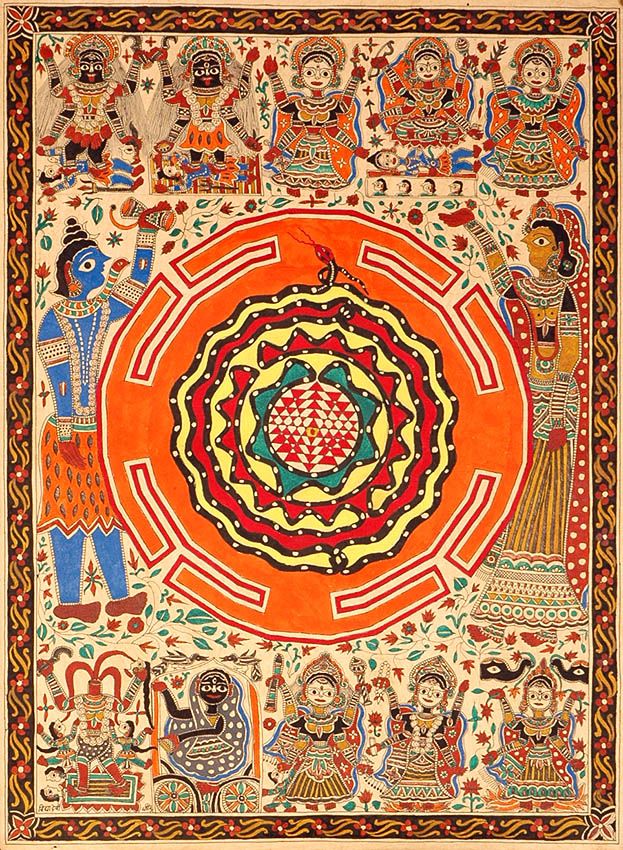Madhubani Painting: The Folk Art of Bihar That Speaks in Colors

Madhubani painting, one of India’s most celebrated folk art forms, originates from the Mithila region of Bihar. Known for its intricate patterns, vibrant colors, and deep-rooted cultural symbolism, this art form has transcended generations, keeping alive the stories of tradition, mythology, and nature. Let’s explore the fascinating world of Madhubani painting and what makes it so special.
1. Origin and History
Madhubani painting traces its roots back over 2,500 years. It is believed to have originated during the time of the Ramayana when King Janaka commissioned artists to paint murals on the walls of his palace for his daughter Sita’s wedding to Lord Rama. Over time, this art form became an integral part of the region’s culture, with women decorating the walls of their homes with intricate designs during festivals and special occasions.
2. Unique Features of Madhubani Painting
Madhubani paintings are easily recognizable due to their distinct characteristics:
- Intricate Patterns: The paintings are filled with fine lines, floral motifs, and geometric designs that create a visually striking effect.
- Vibrant Colors: Traditionally, natural dyes made from flowers, plants, and minerals are used, giving the paintings a rich and earthy feel.
- Symbolism: Each element in a Madhubani painting carries meaning. Peacocks symbolize love, fish represent fertility and prosperity, and the sun signifies energy and life.
- Double Bordering: Most Madhubani artworks have bold double borders with elaborate designs to frame the central subject.
- No Empty Spaces: One of the defining features is the complete coverage of the canvas, ensuring there is no blank space left.
3. Themes and Subjects
Madhubani paintings are deeply connected to the cultural and spiritual life of the Mithila region. Some of the most common themes include:
- Hindu Mythology: Depictions of gods and goddesses like Krishna, Rama, Shiva, Durga, and Lakshmi are prominent.
- Nature and Animals: Birds, fish, trees, and celestial bodies like the sun and moon are often portrayed, symbolizing harmony with nature.
- Marriage and Festivals: Scenes from weddings, especially the "Kohbar" (a bridal chamber painting), and celebrations like Holi and Diwali are frequently depicted.
- Social and Contemporary Issues: Modern Madhubani artists also use this art form to express social messages related to women’s empowerment, environmental conservation, and more.
4. Styles of Madhubani Painting
Over time, Madhubani painting has evolved into five main styles, each with its own distinctive features:
- Bharni Style: Characterized by bright colors and depictions of deities, this style was traditionally practiced by upper-caste women.
- Kachni Style: Known for its fine lines and monochrome detailing, Kachni paintings often focus on animals and mythological figures.
- Tantrik Style: Inspired by religious texts, this style depicts esoteric and tantric themes, such as deities in meditative poses.
- Godna Style: Influenced by tribal tattoo patterns, Godna art consists of repetitive, circular motifs and is often monochromatic.
- Kohbar Style: Traditionally drawn in the wedding chambers, Kohbar paintings symbolize love, fertility, and prosperity.
5. Tools and Materials
Traditional Madhubani paintings were created using natural pigments and homemade brushes:
- Colors: Made from natural sources like turmeric (yellow), indigo (blue), red sandalwood (red), and charcoal (black).
- Brushes: Artists used twigs, bamboo sticks, or even their fingers to paint.
- Canvas: Initially, the paintings were done on mud walls, but today, they are created on handmade paper, cloth, and even modern materials like canvas and fabric.
6. Evolution and Global Recognition
While Madhubani painting was once a household tradition, it gained global recognition in the 20th century. In the 1960s, Indian government officials and art connoisseurs encouraged local artists to transfer their work from walls to paper and cloth, making it accessible to a wider audience. Today, Madhubani art is exhibited worldwide and is used in fashion, home décor, and even contemporary art collaborations.
7. Preservation and Revival
Despite its popularity, traditional Madhubani artists face challenges due to commercialization and mass production. However, several initiatives have been taken to preserve this art form:
- Government and NGO Support: Various organizations provide training and financial aid to local artists.
- Geographical Indication (GI) Tag: Madhubani painting was awarded a GI tag in 2007, ensuring authenticity and recognition for traditional artists.
- Modern Adaptations: Artists are now blending Madhubani with modern themes